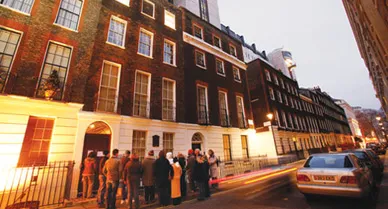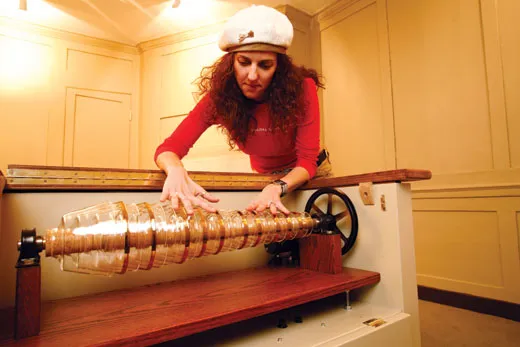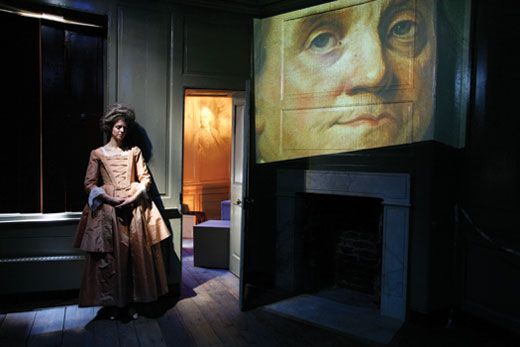Ben Franklin Slept Here
The ingenious founding father’s only surviving residence, in London, is reborn as a museum
Jefferson has his Monticello; Washington, Mount Vernon. Now, thanks to years of dogged fundraising on both sides of the Atlantic, Benjamin Franklin's only surviving residence, Number 36 Craven Street, London, opened its doors to the public on January 17, the 300th birthday of that most amiable and eccentric founding father.
Franklin is better known for his nine-year sojourn in France. But he lived far longer on Craven Street, just off Trafalgar Square. His London years bridged the most turbulent and decisive period of Anglo-American relations. As deputy postmaster general for North America and commercial agent for several of the Colonies, Franklin was at the heart of many of the key discussions and negotiations that would determine the course of American history. Indeed, it could be said that the United States was born on Craven Street.
Franklin arrived in London on July 26, 1757. He was 51 years old, and except for two intervals, the Craven Street house—a five-story Georgian structure built circa 1730—would be his home for the next 16 years. Franklin longed for reminders of home—his wife, Deborah, sent him packages of cornmeal, cranberries and buckwheat flour from Philadelphia—but London afforded him other satisfactions. “Of all the enviable things England has,” he wrote in March 1763, “I envy it most its people. Why should that pretty island, which compared to America is but like a stepping-stone in a brook, scarce enough of it above water to keep one’s shoes dry; why, I say, should that little island enjoy in almost every neighborhood more sensible, virtuous, and elegant minds than we can collect in ranging a hundred leagues of our vast forests?”
As a member of Britain’s Royal Society since 1756, in recognition for his groundbreaking research into electricity and lightning, Franklin had access to London’s lively intellectual, artistic and scientific circles. Visitors to Craven Street included James Boswell, biographer of Dr. Samuel Johnson, and scientist and philosopher Joseph Priestley. In coffeehouses and pubs such as the Dog Tavern or the George and Vulture (the Ship and Shovel, there in Franklin’s day, is still open), Franklin debated the topics of the day.
In a laboratory he installed at the back of his first-floor rooms, he refined the stove that bears his name; identified lead poisoning as the cause of printers’ maladies; invented the Armonica, a musical instrument made up of glass bowls driven by a treadle; wrote pamphlets and articles; worked on his autobiography; and by experimenting with different metals, perfected his famous lightning rod. As a result, lightning rods were placed on many of London’s most famous buildings, including St. Paul’s Cathedral and St. James’ Palace.
And then there were Franklin’s “air baths.” As a young man, he had been a long-distance swimmer at a time when swimming was something most people did only to escape drowning (one of his greatest developments, in my opinion, was the swim fin). He used dumbbells and could, by a slight stretch, be said to have invented the StairMaster by walking up and down the Craven Street house’s stairs (still there, still uneven) for exercise. And early most mornings, before he set to work, Franklin would sit, he wrote to a friend in France in 1768, “without any clothes whatever, half an hour or an hour, according to the season,” at his open, first-floor window, letting the air circulate over his, by then, considerable bulk. What the neighbors thought is apparently not recorded.
Franklin was torn by the growing conflict between Britain and America. He was an Anglophile and an American patriot who believed in the idea of the British Empire and in the rights of the Colonists. “I have lived so great a part of my life in Britain,” he wrote his Scottish friend Henry Home, Lord Kames in 1767. “And formed so many friendships in it, that I love it and sincerely wish it prosperity; and therefore wish to see that union [between Great Britain and the Colonies], on which alone I think it [the British Empire] can be secured and established.”
That union was finally scuppered by what Franklin referred to as “the affair of the tea,” a tax on the import that led outraged Colonists to toss chests of the stuff into Boston Harbor in December 1773. Just a few weeks later, in what must have been one of the most painful moments of his life, Franklin was vilified and humiliated in front of the British Privy Council for his involvement in the so-called Hutchinson Affair. In December 1772, Franklin had leaked confidential letters written by the Crown’s Massachusetts governor, Thomas Hutchinson, exposing the official’s deep antipathy toward the Massachusetts Assembly and fueling anger on both sides of the Atlantic in the run-up to the War of Independence. Shortly after, Franklin was ousted from his position as American postmaster. He made repeated attempts to facilitate a reconciliation between the Crown and the Colonies, but to no avail. In March 1775, he boarded a packet boat back to Philadelphia. He spent his last day in Craven Street with his old chum Joseph Priestley, reading extracts from the American newspapers as tears rolled down his cheeks.
Though I know London well, I had a hard time finding Craven Street, which is tucked away behind Trafalgar Square and Charing Cross Station in a warren of small streets that drop away to the Thames. Today, there is little street life, but in Franklin’s time, the area was full of pubs and restaurants. For much of the past century, the house was owned by British Rail, the national railroad, and served as a hotel and as office space for various nonprofit organizations, including a bird-watching society. British writer C. P. Snow is said to have used the basement as an office in the 1970s. By the 1980s, however, the house was derelict.
The idea to restore the building was first broached by Mary Ponsonby, the American wife of the Earl of Bessborough, who established a trust for that purpose in the late 1980s. But it took almost 20 years more to raise the $5.5 million needed for the renovation. Indeed, without a grant of $2.7 million from the government-run British Heritage Lottery Fund, Franklin’s only remaining residence would probably still be home to rats and squatters.
Instead, for an admission of £8 (about $14), visitors are now treated not to a re-creation of the interior of the house as it was when Franklin lived there but to a high-tech, theatrical experience dramatizing aspects of Franklin’s London years. Starting in the kitchen, an actress playing the part of Polly Stevenson Hewson (the daughter of Franklin’s landlady, Margaret Stevenson) leads visitors through the house. (Polly followed Franklin to America after the War of Independence and was at his bedside when he died.) The rooms are essentially bare—just exposed floorboards and walls painted a muted green, as they would have been in Franklin’s day. Each room is dedicated to a different aspect of the many-faceted man. The first-floor rooms, for instance, where he slept, entertained, conducted scientific experiments and held crucial political meetings with members of the British government, are devoted to Franklin, the public man. Recorded extracts from Franklin’s letters and other writings, re-enacted speeches by members of Parliament and images beamed from ceiling-mounted projectors present visitors with a dramatization of the Hutchinson Affair.
“It’s not like Colonial Williamsburg, where there’s someone churning butter and you engage in conversation,” says the site’s director, Márcia Balisciano. “This is ‘the museum as theater,’ in which the visitor is very much a part of the drama.”
Planning Your Next Trip?
Explore great travel deals
Smithsonian magazine participates in affiliate link advertising programs. If you purchase an item through these links, we receive a commission.


